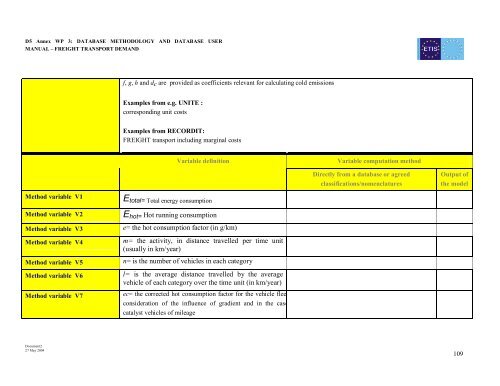D5 Annex report WP 3: ETIS Database methodology ... - ETIS plus
D5 Annex report WP 3: ETIS Database methodology ... - ETIS plus
D5 Annex report WP 3: ETIS Database methodology ... - ETIS plus
Create successful ePaper yourself
Turn your PDF publications into a flip-book with our unique Google optimized e-Paper software.
<strong>D5</strong> <strong>Annex</strong> <strong>WP</strong> 3: DATABASE METHODOLOGY AND DATABASE USER<br />
MANUAL – FREIGHT TRANSPORT DEMAND<br />
f, g, h and dc are provided as coefficients relevant for calculating cold emissions<br />
Examples from e.g. UNITE :<br />
corresponding unit costs<br />
Examples from RECORDIT:<br />
FREIGHT transport including marginal costs<br />
Variable definition<br />
Variable computation method<br />
Directly from a database or agreed<br />
classifications/nomenclatures<br />
Output of<br />
the model<br />
Method variable V1<br />
Method variable V2<br />
Method variable V3<br />
Method variable V4<br />
Method variable V5<br />
Method variable V6<br />
Method variable V7<br />
E total= Total energy consumption<br />
E hot= Hot running consumption<br />
e= the hot consumption factor (in g/km)<br />
m= the activity, in distance travelled per time unit<br />
(usually in km/year)<br />
n= is the number of vehicles in each category<br />
l= is the average distance travelled by the average<br />
vehicle of each category over the time unit (in km/year)<br />
ec= the corrected hot consumption factor for the vehicle fleet, in<br />
consideration of the influence of gradient and in the case of<br />
catalyst vehicles of mileage<br />
Document2<br />
27 May 2004<br />
109
















